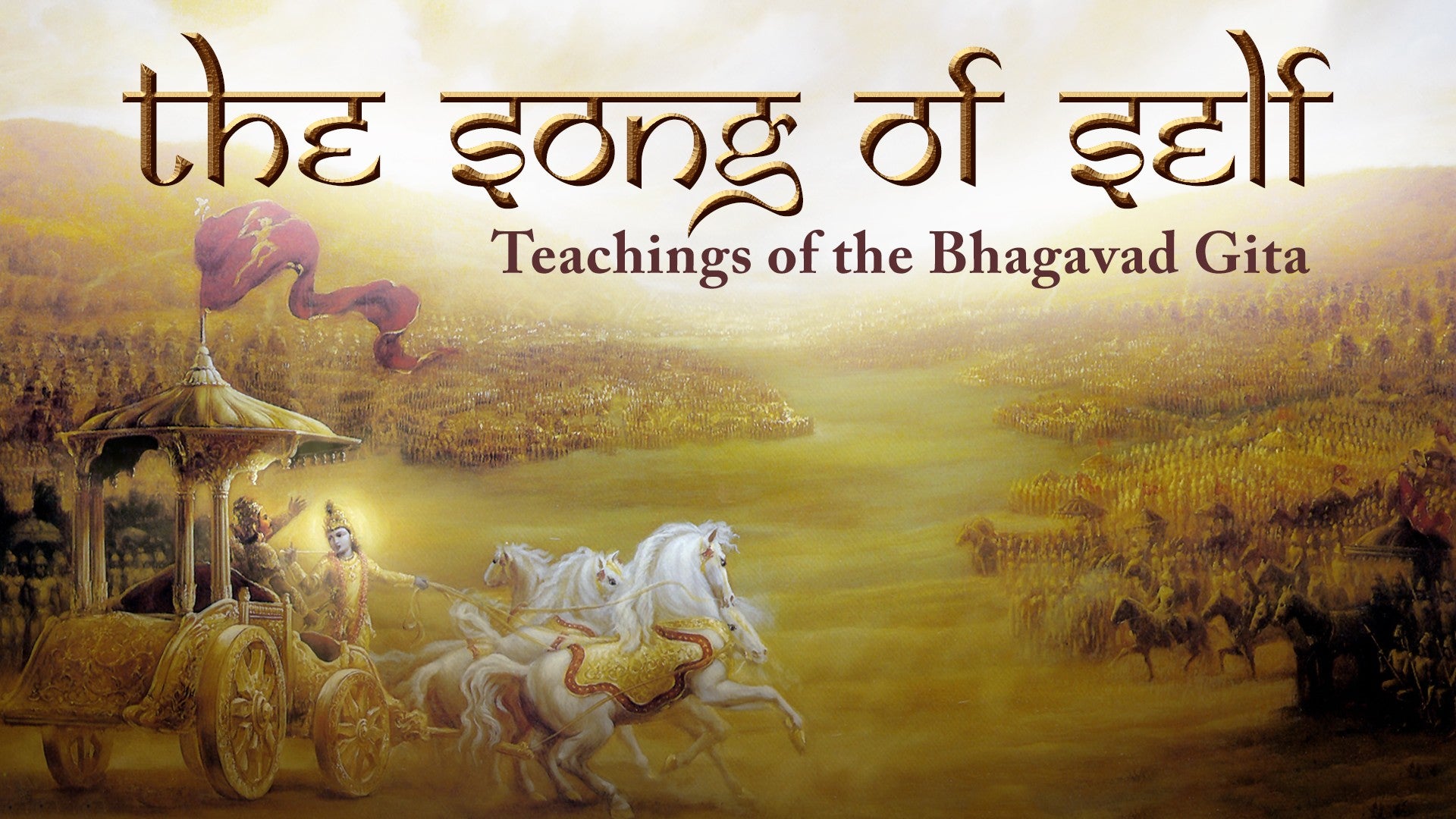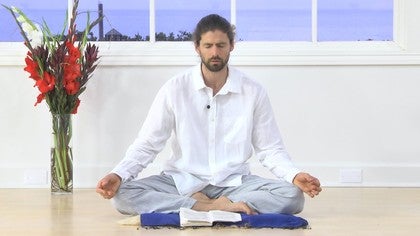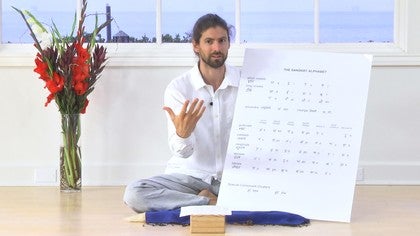Description
About This Video
Transcript
Read Full Transcript
So, why recite? So, in this course, as well as the study of the verses and the discussion of the verses, there's also this resource to develop the practice of reciting the Sanskrit verses. So, in the Indian tradition, recitation is a type of practice and it's often part of study. So, sometimes this can seem a little strange. What's the benefit of learning the verses to such a degree of familiarity that you can recite them? So, in the Indian tradition, there's the idea that when you really know something by heart, it doesn't just mean that you can recall it from memory when you need to, but that it's deep within you. There is the recitation, it kind of implants the teaching into your very selves, because there's the idea that sound is very powerful. And so, in the Indian tradition, there are many sound-based practices. And at a certain level, we could say that really most yoga practices, if not all of them, are about sound and vibration. They're about cultivating harmony through all the layers of the system, bringing everything into oneness or a state of balance. In other words, harmony. And sound is cherished in the Indian tradition because of its power. The area is that sound is pervasive and penetrative. So, for example, you go out somewhere where it's hot and dusty, let's say into a busy downtown area of some city where it's kind of dusty. When you get home, you're probably craving the element of water. And if you take a shower, you can cleanse the element of earth and dust from your skin. If, for example, you found yourself in a rather remote area and you weren't sure if the water supply was completely safe to drink, if you wanted to purify the water, you could use the element of fire to boil heat and purify the water. If there's a fire and you want to take that away, then you can use the element of the air to cool it and blow it out and then blow away the smoke. So, it's the idea in the Indian system that we can cleanse the elements with the sopular one. So, you can cleanse earth with water, water with fire, fire with air. And it's the idea that we're constituted of these elements. If you want to purify all of them, what do we use? So, it's the idea that the different elements correspond to our senses. Earth has fragrance, water has sweet taste, fire, it's bright, you can see it, so it corresponds to the field of vision. Air, you can feel it on your skin. So, it corresponds to the sense of touch. And that leaves the sense of hearing, which corresponds to space or akasha, that in which all the other elements exist. And so, there's the idea that as soon as we start working with sound, very directly, very immediately, it can have a whole system effect. It can start to cultivate harmony at a very deep level. Sometimes, for example, if you go to a yoga class, they might start the class by chanting om, for example. As you let this sound resonate through the whole body, it starts to kind of allow you to feel how you are all connected. It gets you in tune with your body. So, you might be up here in your head thinking about all the things you have to do. When you let om resonate through your body, it kind of activates that connectivity to the whole of the system. So, sound is recognized as being powerful, penetrative, and pervasive. The Bhagavad Gita, however, as well as being a sound-based practice, or the recitation of it being a sound-based practice, Gita means song. And we could sometimes say, if we wanted to, that the Gita is about coming to that state of integration on mastery so we can actually sing our own song in the world. We can actually be in harmony in the world. But these verses, most of the verses in the Gita are in the most common meter in Sanskrit, which is called Anustraup, and it's got 32 syllables. This is quite interesting. Now, when I was a boy, computers often had 32K. Some of them had 16K, some of them had 64K. Now, these days, you probably get more K in a set of car keys or something like that. But back all those years ago, when I was a small boy, it wasn't unusual for a computer to have 32K. And now, even though the computers are much more powerful, they still use 8-bit code to condense vast amounts of information. But this is actually nothing new. This is what they were doing in India thousands of years ago, because they were condensing vast amounts of teaching or useful information into poetry, such as the Gita, where all the teachings are encoded in these verses, which we might say use this 8-bit code. So the most common meter is called Anustraup. It has 32 syllables in each verse, and it's divided into eight feet or quarters. And I've noticed that in other languages too, when poems have eight syllables a line, they're generally relatively very easy to commit to memory. This is something that hasn't been so much research into, but they've started doing research into it. And from my Sanskrit teachers, they've discovered that there's something about this eight-syllable pattern that makes it easier to commit to memory. There's something about these eight syllables that somehow resonates with our human brain. I don't know much about that, but I do know from experience that it's true, that these 8-8-8-8 verses are relatively easy to commit to memory. So if you start practicing reciting, you might find there's not very long before a few, and then perhaps many, and perhaps the whole chapter, you kind of have them.
At the beginning that might sound like a lot, but if you practice, you'll find slowly, surely you'll start to know more and more of them. And they say the more you practice, like the first ten are harder to memorize than the next ten. And once you've got a few verses down, then it'll be easier. And you won't just be training your memory, you'll also be training the tongue. We've also spoken about the Sanskrit alphabet and the sounds. And it's important to remember, when we start the recitation practice, we're basically asking our tongue to perform maneuvers that it might never have performed ever before. So if now and again you get a little bit tongue-twisted, this is completely normal, nothing to be disheartened about. But with practice, it's like you're training the muscle to do something it hasn't done before. So again, slowly, steadily, you'll find it becoming more and more easy. But hopefully, if you do decide this is a practice you'd like to cultivate and explore, it will be its own reward. You know, you'll recite and it will feel, you'll feel this harmonizing effect, this kind of grounding effect of working with the recitation. And this is another of the benefits. So they've also done research about the effects of recitation in this meter. And they've hooked people up to brainwave reading machines. I don't know the actual correct terminology to describe such a thing. But they've put people with these brainwave, they put nodes on the brain. And they've found that when people recite in Sanskrit, in this meter, before very long, after just a couple of minutes, there emerge in the brain these beautiful kind of crystallized patterns of activity in both hemispheres with the brain. And this is the same type of mental, balanced mental activity that they find when people go into deep meditative states. And this is one of the ideas that when you recite it, it is a meditative practice. We've already mentioned during the course, what is meditation? It means to be steady, centered in the midpoint. So the recitation serves as a point of focus, which we can use to come back to the center. And when we have to focus on the verses, it's a way to be active, yet centered. And so recitation practice is one of those practices in the yoga system, where we start to move from internal kind of quieter integrated state to more active integrated state. So it's an interesting thing to explore. And for me, I've also found it's a very enjoyable thing to explore. My Sanskrit teachers say, the more you practice reciting Sanskrit, the better you'll be able to speak all the other languages you know.
I'm not sure if this is really true, but I can say I used to work in Thailand. And that's where my first Sanskrit teacher is. And a few years ago, I went back to visit, having not spoken Thai or been in Thailand for a couple of years. And my Sanskrit teacher said to me, your Thai is so good. What has happened? And I said, I haven't spoken. And she said the same. It must be because of Sanskrit. But first and foremost, it's a yoga practice, so it invites us to be present. And I think if it's a practice that resonates for you, if you give it some attention, you'll find it does invite you into that present and lively space. So I hope the practice is on reward, and you enjoy it. So from here, we're going to include now a section as a kind of guide to recitation, and how you can start to work steadily with the verses.
The Song of Self: Let's Recite
Comments

You need to be a subscriber to post a comment.
Please Log In or Create an Account to start your free trial.











